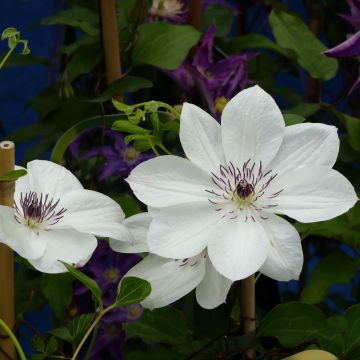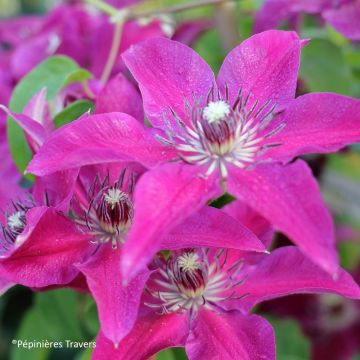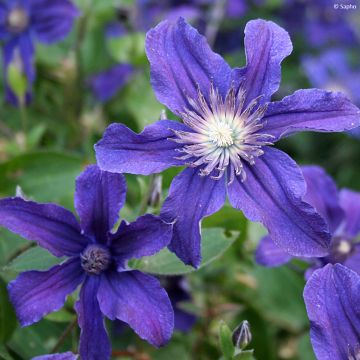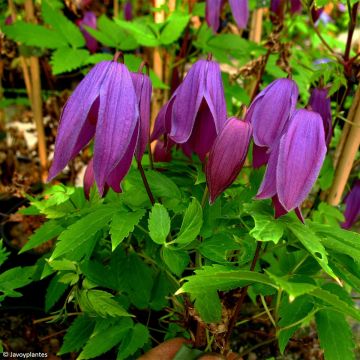

Clématite viticella Palette


Clématite viticella Palette


Clématite viticella Palette
Clematis Palette
Clematis patens Palette
Early Large-flowered Clematis
Thanks to Ludivine for preparing the order and Anaïs from the shipping department, the received clematis is dormant but appears to be healthy. I have planted it near an arch and now I am patiently waiting for it to come back to life in spring (or not)...
Thierry, 26/01/2022
This item cannot be shipped to the selected country
Delivery charge from €5.90
More information
Schedule delivery date,
and select date in basket
This plant carries a 6 months recovery warranty
More information
We guarantee the quality of our plants for a full growing cycle, and will replace at our expense any plant that fails to recover under normal climatic and planting conditions.
From €5.90 for pickup delivery and €6.90 for home delivery
Express home delivery from €8.90.

Does this plant fit my garden?
Set up your Plantfit profile →
Description
Clematis 'Palette' is a brand new Dutch introduction, interesting for its very compact growth and its unique flower shape and colour. Its large and beautiful flowers resemble 6-branched purple stars, finely edged with purple ripples for a stunning effect. The intensity of this colour is enhanced by a creamy stamen centre. This deciduous climber blooms abundantly in spring and again during summer. Hardy and non-invasive, it will fit anywhere in the garden or on the terrace!
The genus Clematis belongs to the buttercup family. 'Palette', obtained in 2005 in the Netherlands, was only introduced to the horticultural market in 2016. It is a horticultural variety belonging to the group of Clematis Patens. It is a semi-woody climbing perennial plant that will not exceed 2m (7ft) high in open ground, even less in a pot, with a spread of 1 to 2m² and rapid growth.
This clematis has 10 to 12cm (4 to 5in) diameter flowers on the previous year's wood in spring, from April to June, and then again on the current year's shoots in summer. The flowers are solitary or grouped in cymes and particularly abundant. They are upright and have 6 to 8 long triangular tepals with wavy edges. Each tepal is a very bright light violet in the centre, highlighted by a fine purplish border. The flowers are followed by decorative, feathery, silver-grey seed heads that remain until winter. The deciduous leaves are divided into 3 small rounded, smooth, medium-green leaflets. This clematis clings to support or host plants with tendrils.
Plant clematis alongside your climbing roses or ramblers to extend the flowering of your walls and pergolas until the end of summer. It is a genus rich in diversity, with flowers of all colours, shapes, and sizes. Take advantage of their easy cultivation to give your garden a romantic and bohemian touch. You can always find space for 'Palette' in the garden. It loves to climb in bushes and pairs well with the pink flowers of lilacs, deutzias, or Kolkwitzia amabilis Pink Cloud. It also performs well in a pot on a terrace or balcony. Create unique spring bouquets by picking a few branches loaded with flowers, mixed with pink or purple peonies, Angelique tulips, "red" or mauve or pink irises, and many other garden flowers.
Report an error about the product description
Clematis Palette in pictures




Plant habit
Flowering
Foliage
Botanical data
Clematis
patens
Palette
Ranunculaceae
Early Large-flowered Clematis
Cultivar or hybrid
Other Clematis Patens
Planting and care
Clematis Palette likes a sunny or lightly shaded position near a tree. Plant it in fertile, humus-rich, well-drained soil, shading the roots and base of the stem (with a flat tile, for example). Clematis can suffer in soil that is too wet in hot weather, falling victim to clematis wilt. Plant it by covering the root ball with 3 cm (1in) of soil, in soil worked to a depth of 20 cm (8in), lightened with good compost and coarse sand. After planting, cut back the clematis stems to about 30 cm (12in) from the base above a healthy pair of buds. During the first few weeks, water regularly but be careful not to let the water stagnate as this can lead to the development of a fungus at the base of the stem. Mulch all clematis plants in February with garden compost or well-decomposed manure, avoiding direct contact with the stems. Train the stems, without crushing them, until the plant can grip onto its support. Clematis also like to grow freely on neighbouring plants. Remove dead or weak stems in March, before the start of growth, and cut back all others above 2 healthy buds. They will produce secondary stems that will bear lateral shoots flowering in May. Remove faded flowers. The young shoots will bloom later in the season.
After a few years, cover the base of your climbing clematis with a small mound of soil, this will reduce the risk of wilt while promoting the growth of vigorous new shoots from the crown. Voles and slugs can attack clematis and devour the stems. Aphids and greenhouse whiteflies are also potential pests.
Planting period
Intended location
Care
-
, onOrder confirmed
Reply from on Promesse de fleurs
Clematis
Haven't found what you were looking for?
Hardiness is the lowest winter temperature a plant can endure without suffering serious damage or even dying. However, hardiness is affected by location (a sheltered area, such as a patio), protection (winter cover) and soil type (hardiness is improved by well-drained soil).

Photo Sharing Terms & Conditions
In order to encourage gardeners to interact and share their experiences, Promesse de fleurs offers various media enabling content to be uploaded onto its Site - in particular via the ‘Photo sharing’ module.
The User agrees to refrain from:
- Posting any content that is illegal, prejudicial, insulting, racist, inciteful to hatred, revisionist, contrary to public decency, that infringes on privacy or on the privacy rights of third parties, in particular the publicity rights of persons and goods, intellectual property rights, or the right to privacy.
- Submitting content on behalf of a third party;
- Impersonate the identity of a third party and/or publish any personal information about a third party;
In general, the User undertakes to refrain from any unethical behaviour.
All Content (in particular text, comments, files, images, photos, videos, creative works, etc.), which may be subject to property or intellectual property rights, image or other private rights, shall remain the property of the User, subject to the limited rights granted by the terms of the licence granted by Promesse de fleurs as stated below. Users are at liberty to publish or not to publish such Content on the Site, notably via the ‘Photo Sharing’ facility, and accept that this Content shall be made public and freely accessible, notably on the Internet.
Users further acknowledge, undertake to have ,and guarantee that they hold all necessary rights and permissions to publish such material on the Site, in particular with regard to the legislation in force pertaining to any privacy, property, intellectual property, image, or contractual rights, or rights of any other nature. By publishing such Content on the Site, Users acknowledge accepting full liability as publishers of the Content within the meaning of the law, and grant Promesse de fleurs, free of charge, an inclusive, worldwide licence for the said Content for the entire duration of its publication, including all reproduction, representation, up/downloading, displaying, performing, transmission, and storage rights.
Users also grant permission for their name to be linked to the Content and accept that this link may not always be made available.
By engaging in posting material, Users consent to their Content becoming automatically accessible on the Internet, in particular on other sites and/or blogs and/or web pages of the Promesse de fleurs site, including in particular social pages and the Promesse de fleurs catalogue.
Users may secure the removal of entrusted content free of charge by issuing a simple request via our contact form.
The flowering period indicated on our website applies to countries and regions located in USDA zone 8 (France, the United Kingdom, Ireland, the Netherlands, etc.)
It will vary according to where you live:
- In zones 9 to 10 (Italy, Spain, Greece, etc.), flowering will occur about 2 to 4 weeks earlier.
- In zones 6 to 7 (Germany, Poland, Slovenia, and lower mountainous regions), flowering will be delayed by 2 to 3 weeks.
- In zone 5 (Central Europe, Scandinavia), blooming will be delayed by 3 to 5 weeks.
In temperate climates, pruning of spring-flowering shrubs (forsythia, spireas, etc.) should be done just after flowering.
Pruning of summer-flowering shrubs (Indian Lilac, Perovskia, etc.) can be done in winter or spring.
In cold regions as well as with frost-sensitive plants, avoid pruning too early when severe frosts may still occur.
The planting period indicated on our website applies to countries and regions located in USDA zone 8 (France, United Kingdom, Ireland, Netherlands).
It will vary according to where you live:
- In Mediterranean zones (Marseille, Madrid, Milan, etc.), autumn and winter are the best planting periods.
- In continental zones (Strasbourg, Munich, Vienna, etc.), delay planting by 2 to 3 weeks in spring and bring it forward by 2 to 4 weeks in autumn.
- In mountainous regions (the Alps, Pyrenees, Carpathians, etc.), it is best to plant in late spring (May-June) or late summer (August-September).
The harvesting period indicated on our website applies to countries and regions in USDA zone 8 (France, England, Ireland, the Netherlands).
In colder areas (Scandinavia, Poland, Austria...) fruit and vegetable harvests are likely to be delayed by 3-4 weeks.
In warmer areas (Italy, Spain, Greece, etc.), harvesting will probably take place earlier, depending on weather conditions.
The sowing periods indicated on our website apply to countries and regions within USDA Zone 8 (France, UK, Ireland, Netherlands).
In colder areas (Scandinavia, Poland, Austria...), delay any outdoor sowing by 3-4 weeks, or sow under glass.
In warmer climes (Italy, Spain, Greece, etc.), bring outdoor sowing forward by a few weeks.























































